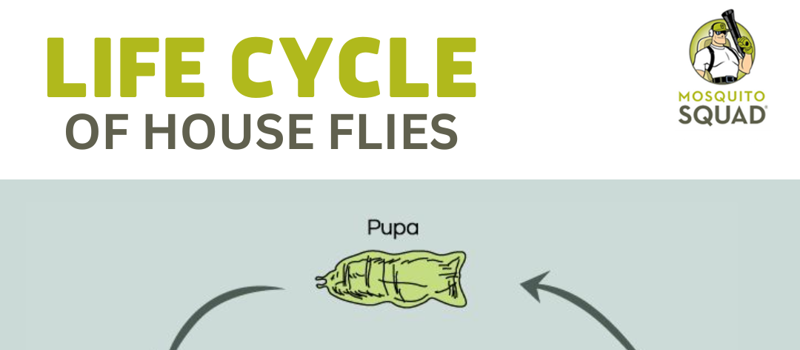Understanding the Life Cycle of Flies: A Comprehensive Guide
Posted by Mosquito Squad
December 19, 2023
Flying insects are classified as part of the Diptera order, which is Greek for "two wings." They can be found in a variety of habitats and are crucial pollinators and decomposers in ecosystems. The management and control of fly populations can be aided by an understanding of their life cycle. Here is a thorough explanation of the fly life cycle:
Egg Stage:
When a female fly lays eggs, the life cycle of a fly begins. Fly eggs are typically laid in moist or decomposing organic matter where their larvae, known as maggots, can find food. Species and environmental factors affect how many eggs are laid.
Larvae Stage:
Larvae appear after the eggs hatch. These worm-like, legless larvae are commonly referred to as maggots. Their head is sizable, and their body is soft. Maggots eat rotting organic matter like fruits, vegetables, animal carcasses, and garbage with a voracious appetite. This feeding phase aids in the recycling of organic material and simplifies it into compounds that are more basic.
Pupal Stage:
Maggots move into the pupal stage after leaving the larval stage. The puparium, which serves as the maggot's protective covering, allows it to go through an amazing transformation. The maggot transforms into an adult fly during this stage, undergoing significant changes to its body composition and organ systems. Depending on the species and the surrounding environment, the pupal stage can last anywhere from a few days to several weeks.
Adult Stage:
The puparium is where the adult fly emerges once the metamorphosis is finished. A soft fly with folded wings has just emerged. The exoskeleton and wings of the fly take some time to harden and develop into their full functionality. The fly begins searching for food and mates once it is ready.
Mating and Reproduction:
Flies have a brief lifespan, and their main objective as adults is to mate and produce offspring. Male flies frequently display territorial behavior and engage in conflict over mates. After becoming receptive, a female mates and stores the sperm for later use. Depending on the species, flies can have monogamous or polygamous mating systems.
Egg-Laying:
Female flies look for suitable places to lay their eggs after mating. They are drawn to organic matter that has started to decompose, faeces, or other suitable substrates where their larvae can find an abundance of food. The life cycle of the fly is completed by repeated egg-laying.
It's significant to remember that each stage of the life cycle can last for a different amount of time depending on the species, environmental factors like temperature and food availability, and other circumstances. Since flies are known for their propensity for rapid reproduction, efficient fly control strategies frequently concentrate on disrupting their life cycle by removing breeding grounds or applying selective insecticides.
Implementing preventive measures to lower fly populations and more effectively manage their presence can be made possible by having a better understanding of the fly's life cycle.
In conclusion, Mosquito Squad offers fly control treatments that can help address infestations of inside flies and fruit flies. While their primary focus is mosquito control, they may also provide additional services for fly management. Their professional fly control treatments involve thorough inspections, targeted treatments, identification, and removal of breeding sources, and prevention strategies. While the specifics of their guarantees and 100% guaranteed services may vary, it's advisable to contact Mosquito Squad directly to understand the details of their offerings. By seeking professional assistance, individuals can effectively control fly populations and create a more fly-free environment.
